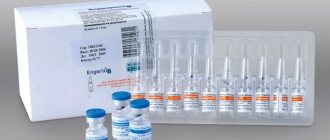"HAVRIX" - vaccination against hepatitis A
Viral inactivated hepatitis A antigen
Manufacturer: GlaxoSmithKline Biologicals, Belgium.
Protects against viral diseases: hepatitis A.
Trying on:
- Vaccine "Havrix 720 units" - for vaccination of children under 16 years of age.
- Vaccine "Havrix 1440 units" - for vaccination of children over 16 years of age and adults.
Not included in the national calendar of preventive vaccinations in Russia.
Benefits of the Havrix vaccine
- A single administration of the vaccine stimulates the rapid development of specific cellular and humoral immunity factors and the production of antibodies to the hepatitis A virus.
- Two doses of the vaccine, administered at intervals of 6-18 months, provide protection against clinically manifest forms of hepatitis A for a period of at least 20 years.
- Vaccination prevents the spread of infection, since protective antibodies appear in the blood already 13 days after vaccination.
- The Havrix vaccine does not reduce its effectiveness if there are maternal antibodies to the hepatitis A virus or passively administered antibodies to the hepatitis A virus in the blood of the vaccinated person.
- The predicted duration of immune protection is 30 years for 95% of vaccinated people and 40 years for 90% of vaccinated people.
- The Havrix vaccine is weakly reactogenic.
Scheme and method of administration of the Havrix vaccine
The Havrix vaccine is administered intramuscularly into the deltoid muscle area. For children aged 12–24 months, the vaccine is administered to the anterolateral thigh.
The vaccine should not be administered into the gluteal muscle or subcutaneously or intradermally, since the formation of antibodies to the hepatitis A virus may not reach optimal levels with these routes of administration.
A single dose of the vaccine is:
- for children from 12 months to 16 years - 0.5 ml;
- for children over 16 years of age and adults - 1.0 ml.
Primary immunization is carried out with one dose of the vaccine. The optimal period for administering a booster dose is 6–12 months after primary immunization. If revaccination is not carried out within 6 to 12 months and it is necessary to ensure protection against hepatitis A infection, revaccination is carried out up to 60 months after the first dose.
Indications for vaccination "Havrix"
Children and adults who are or will be at risk of contracting viral hepatitis A should be vaccinated:
- people living in areas with high incidence of hepatitis A;
- children and adults traveling on vacation or for work to regions with a high incidence of hepatitis A (military personnel, travelers, etc.);
- children and adults visiting swimming pools;
- children and adults visiting public catering places (restaurants, cafes);
- people who are contacts of hepatitis A outbreaks;
- people at occupational risk of infection: medical personnel and patient care personnel (especially in infectious diseases, gastroenterological and pediatric departments); staff of preschool institutions; sewer and water supply workers; food industry and catering personnel;
- persons from special risk groups (patients with chronic liver disease or an increased risk of liver disease; patients with hemophilia; patients with multiple blood transfusions; drug addicts; homosexuals; persons who are promiscuous).
Compatibility with other vaccines
The Havrix vaccine can be administered simultaneously with such vaccines of the National Preventive Vaccination Calendar and the Preventive Vaccination Calendar for epidemic indications, such as: a vaccine for the prevention of typhoid fever, a vaccine for the prevention of yellow fever, a vaccine for the prevention of tetanus, monovalent and combined vaccines for the prevention of measles, mumps , rubella, chickenpox.
When administered simultaneously with human immunoglobulins, the protective effect of the vaccine is not reduced.
If it becomes necessary to administer the Havrix vaccine with other vaccines or with immunoglobulins, the drugs are administered using separate syringes and needles in different parts of the body.
Vaccine Havrix 720 units 0.5 ml N1 suspension for injection syringe
Release form
Suspension for intramuscular administration for adults
Package
1 syringe.
pharmachologic effect
The Havrix vaccine provides protection against hepatitis A, forming specific immunity by inducing the production of antibodies against the hepatitis A virus (HAV), as well as activating cellular immune mechanisms.
Clinical studies have shown that 99% of vaccinated individuals achieved seroprotection (> 20 mIU/ml) 30 days after the first dose. Data obtained from two-time administration of the vaccine with an interval of 6-12 months allow us to conclude that 97% of those vaccinated 25 years after the course will have a protective antibody titer (>20 mIU/ml). When studying the kinetics of the immune response, it was found that after administration of one dose of the Havrix vaccine, seroprotection was achieved in 79% of vaccinated people on the 13th day, in 86.3% - on the 15th day, in 95.2% - on the 17th day, and for 99% - on the 19th day, i.e. these time intervals are shorter than the average incubation period for hepatitis A (4 weeks).
The effectiveness of the Havrix vaccine was assessed during outbreaks of the disease that affected large groups of the population (Alaska, Slovakia, USA, UK, Israel, Italy), as well as in families and organized children's groups. These studies showed that Havrix vaccination resulted in the cessation of outbreaks. With vaccination coverage of at least 80% of the susceptible population, the outbreak of the disease is achieved within 4-8 weeks.
To ensure long-term protection, a second (booster) dose should be administered between 6 and 12 months. after the first dose. It was found that revaccination carried out up to 12-60 months after vaccination induces the production of the same level of antibodies as revaccination carried out 6-12 months later. after vaccination.
Based on the available data, it can be concluded that persons with an unchanged immune status after a two-dose vaccination course do not need additional revaccination.
Indications
Prevention of hepatitis A from 12 months of age.
Contraindications
Hypersensitivity to any component of the vaccine; symptoms of hypersensitivity to previous administration of the Havrix vaccine.
Acute infectious and non-infectious diseases, exacerbation of chronic diseases are temporary contraindications for vaccinations; for mild ARVI and acute intestinal diseases, vaccinations are carried out immediately after the temperature has normalized.
Use during pregnancy and breastfeeding
Due to the lack of adequate data on the use of the vaccine during pregnancy and lactation, administration of Havrix to pregnant and lactating women is not recommended, despite the minimal risk of exposure of the fetus and child to inactivated vaccines.
Havrix during pregnancy and lactation should be used only if there are absolute indications.
special instructions
In areas with low or moderate endemicity of hepatitis A, immunization with Havrix is particularly recommended for persons at increased risk of infection, persons in whom hepatitis A may be severe, or persons whose occupational status of hepatitis A may lead to outbreaks. . These include:
persons traveling to hyperendemic regions or to regions where outbreaks of hepatitis A are being reported. Travelers:
Military personnel: employees of military units stationed in areas with poor sanitation conditions or unguaranteed water supplies.
Persons whose hepatitis A disease, due to their occupation, can lead to outbreaks
and for whom there is an occupational risk of contracting the hepatitis A virus: employees of schools and preschool institutions, paramedical and junior medical personnel, especially in infectious diseases, gastroenterological and pediatric treatment and prophylactic institutions, workers of sewerage systems and water treatment facilities, employees of catering establishments and the food industry — food warehouses, personnel of closed institutions of the GUIN system, social security and medical institutions.
Persons living or staying in hepatitis A outbreaks, including family ones, or living in areas where outbreaks are registered.
Persons with a behavioral risk of contracting the hepatitis A virus: homosexuals, people who are promiscuous, drug addicts who inject drugs.
Patients suffering from hemophilia
Persons who have household contacts with an infected person. Virus shedding can occur over a fairly long period of time. In this regard, vaccination is recommended for all persons in contact with the infected person.
Population groups with a known high incidence of hepatitis A or those population groups in which the incidence of hepatitis A is increased due to poor sanitary and hygienic conditions.
Persons with chronic liver diseases or an increased risk of liver diseases (chronic carriers of hepatitis B, C, delta viruses, persons suffering from chronic hepatitis of alcoholic, autoimmune, toxic, drug and other origins, persons with Wilson-Konovalov disease, hepatoses and hepatopathies).
In regions of moderate or high endemicity, hepatitis A vaccination is recommended for the entire susceptible population.
Compound
1 ml of vaccine contains 720 ELISA units of hepatitis A virus antigen;
excipients: Aluminum hydroxide - 0.5 mg (sorbent), 2-phenoxyethanol - 5 mg (preservative), a mixture of amino acids, sodium hydrogen phosphate, potassium dihydrogen phosphate, polysorbate 20, potassium chloride, sodium chloride, neomycin sulfate (traces), water for injections.
Directions for use and doses
The Havrix vaccine is intended for intramuscular administration.
For adults and older children, the vaccine should be injected into the deltoid muscle area, and for children 12-24 months old - into the anterolateral thigh area.
The vaccine should not be administered into the gluteal muscle, or subcutaneously, since with such routes of administration, the formation of antibodies to the hepatitis A virus may not reach the optimal level.
Vaccination schedules
A single dose for primary vaccination for adults and adolescents over 16 years of age is 1.0 ml, for children and adolescents under 16 years of age - 0.5 ml.
Revaccination is carried out 6-12 months after vaccination, using an age-appropriate dosage of the drug.
The optimal interval between vaccinations is 6-12 months. The revaccination (booster) effect is achieved with the administration of a booster dose and in the period 12-60 months after the administration of the vaccination dose.
Side effects
The Havrix vaccine is generally well tolerated.
Local reactions may develop: short-term pain at the injection site was assessed as severe in less than 0.5% of cases); redness and swelling, the frequency of which was about 4% of the total number of vaccinations performed.
General reactions are predominantly mild, and the duration of most of them did not exceed 24 hours. General reactions included headache, malaise, vomiting, fever, nausea and loss of appetite. The incidence of these events ranged from 0.8% to 12.8% of the total number of vaccinations. All these adverse events passed without consequences.
The nature of adverse reactions and symptoms in children was the same as in adults, but in them adverse reactions were observed with less frequency. During post-registration observations, in rare cases, phenomena such as fatigue, diarrhea, myalgia, arthralgia, allergic reactions, including anaphylactoid reactions, and convulsions were noted.
Drug interactions
The Havrix vaccine can be administered simultaneously with inactivated vaccines of the national calendar of preventive vaccinations of the Russian Federation and the vaccination calendar according to epidemic indications of the Russian Federation.
When administered simultaneously with inactivated vaccines against typhoid, cholera, tetanus, and yellow fever, no decrease in the immune response to the Havrix vaccine was observed.
When administered simultaneously with human immunoglobulins, the protective effect of the vaccine is not reduced.
If it becomes necessary to administer Havrix with other vaccines or with immunoglobulins, the drugs are administered using different syringes and needles in different parts of the body.
Storage conditions
The vaccine should be stored and transported at a temperature of +2 to +8 ° C.
Do not freeze! If frozen, the vaccine must not be used.
Contraindications
Only a doctor can decide whether Havrix is suitable for a child to be vaccinated
Vaccination with Havrix is contraindicated if there is a history of an allergic reaction to any component of the vaccine and in the following cases:
- Acute infectious and non-infectious diseases, exacerbations of chronic diseases. The vaccination is carried out no earlier than 1 month after recovery (remission).
- Severe reaction (temperature above 40°C; hyperemia, swelling at the injection site with a diameter of more than 8 cm) with the previous administration of the drug.
- Immunodeficiency conditions, malignant blood diseases and neoplasms.
- Pregnancy.
- Hypersensitivity to any component of the vaccine.
- Hepatitis A seropositivity
How to help your young child feel comfortable during vaccinations
Vaccination works better when the baby is calm and not afraid. To avoid scaring your child, try the following:
- Distract and calm your baby, hug him, talk softly to him
- Be calm, confident, smile.
- Maintain eye contact with your child
- Communicate with your child, show that you are nearby and everything is fine.
- Let your child hold a favorite toy or blanket.
- Ask your doctor if you can hold your baby on your lap and gently rub his back during vaccination.
- Be sure to praise your child after vaccination, tell him how great he is and how proud you are of him.
- Support your baby, even if he couldn't help but cry.
Possible side effects
Pain and redness at the injection site, fatigue, malaise, fever (≥ 37.5°C), injection site reactions (such as swelling or induration), diarrhea, nausea, vomiting, headache, drowsiness, loss of appetite.
Anaphylaxis, allergic reactions, including anaphylactoid reactions and symptoms of an allergic condition resembling those of serum sickness. Cramps. Vasculitis. Angioedema, urticaria, erythema multiforme. Arthralgia.
Havrix should be administered with caution to patients with thrombocytopenia or bleeding disorders as bleeding may occur in these patients following intramuscular injection. After the injection, such patients should apply a pressure bandage (but do not rub) for at least 2 minutes. The vaccinated person must be under medical supervision for 30 minutes after immunization.
Come get vaccinated at ONNI.
A full range of vaccines for children and adults, family vaccinations - at a special price! Call a doctor at home Make an appointment with a doctor or call +7 (812) 331-17-74



